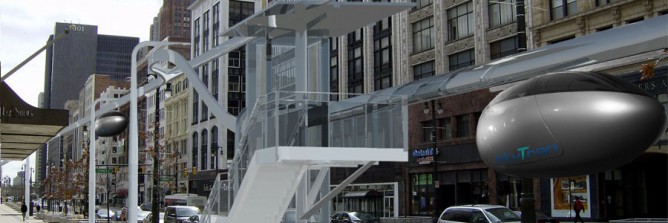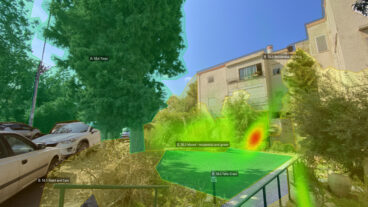Space-age public transport is coming to Israel by the end of next year.
NASA Space Act company skyTran signed a deal earlier this month with Israel Aerospace Industries (IAI) to construct a 400- to 500-meter loop demonstration system of its proprietary magnetic levitation-powered high-speed, low-cost, elevated personal rapid transit at IAI’s corporate campus.
If it’s successful, the next installation will be in Tel Aviv. After that, the sky’s the limit.
“As soon as the first system is built, we intend to replicate it in Israel and around the world,” CEO Jerry Sanders tells ISRAEL21c.
skyTran is a patented system of computer-controlled, two-person “jet-like” vehicles developed at the NASA Ames Research Center in California. The system is meant to revolutionize urban and suburban commuting in a fast, safe, green and economical manner.
Passengers will be able to tap a smartphone icon to order a vehicle to meet them at a specific station. Inside the pod, passengers choose a destination from an on-board console. About 12,000 commuters can be transported on each guideway per hour. The demo system will travel at up to 70 kilometers (43 miles) per hour, while the commercial system is expected to move as quickly as 240km (149 miles) per hour.
Little airplanes
Sanders says it made sense to seek an aviation partner to help skyTran design and build the futuristic transport pods, “because our vehicles are in fact little airplanes flying on magnetic waves,” he explains.
“I had a feeling IAI would be our best partner because of its innovative outlook and great engineering depth. We hoped they would be receptive to paradigm-breaking concepts simply because they are Israelis. We were delighted to find they were receptive and spent a lot of resources checking the feasibility of the concept.”
As ISRAEL21c reported in November 2012, Sanders hoped to have the first skyTran system installed in Israel within two years.
He is still optimistic that the first seven-kilometer installation near Tel Aviv University will happen fairly quickly, followed by a 125-mile network covering all of central Israel. The first phase is expected to cost $50 million to $80 million.
“The systems are very profitable and can attract bond money and private investment, and are much cheaper to build than traditional public transportation,” Sanders says.
The cost of implementing skyTran is estimated at $9 million per mile, as opposed to $100 million per mile for a light-rail system and $20 million per lane for buses — with the added benefits of energy conservation and low setup, installation and maintenance costs.
“The only holdup is government bureaucratic approval,” Sanders says. “This plan is supported by every government ministry in Israel. But it requires changing Israel’s master plan to include skyTran because it now includes only rail, and there is no quick shortcut to changing regulations.”
The Ministry of Finance has already allocated funding, he adds.
Simpler than LEGO
Other skyTran routes in advanced planning are in Toulouse, France; Kerala, India; and the San Francisco Bay Area, California.
“Once the Israeli system is up and running, people from all over the world will come to see it,” predicts Sanders. “Folks from India to Latin America are waiting to buy it but they want to see a system in action first.”
He says that future skyTran systems would take a short time to build, as opposed to the demo system at IAI that must be constructed by hand.
“Once the first vehicle and guideways are up, you turn on a production line and it moves very quickly. All we do is a very simple construction process. When the land survey is done, we embed poles in cement and hang the guideways on the poles. It’s simpler than LEGO,” says Sanders.


















